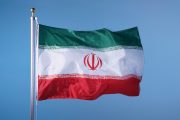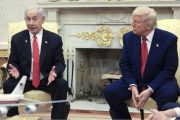
SINGAPORE — Iran has been witnessing escalating nationwide demonstrations protesting the death of Mahsa Amini, a 22-year-old woman who died on September 16 in questionable straits after her detainment for reportedly wearing her hijab imporperly.
In response, the Iranian regime has severely reined in the protesters. Its repression includes supposed arbitrary detainments, sexual violence, overt use of torture, force, “disappearances,” and executions. Iran’s efforts are allegedly supported by Chinese artificial intelligence (AI) surveillance technology.
For nearly three months, thousands of people have been gathering daily in protests across Iran after Amini died. About a week before Amini’s death, during the 2022 summit of the Beijing-led Shanghai Cooperation Organization, Iran further reinforced its economic and political relations with China. Iran’s cozying up to China includes its adoption of technology for social control, noted an MIT Technology Review.
A new study by the Foundation for Defense of Democracies (FDD) elucidated the degree to which Chinese AI technologies are helping the Iranian regime crush dissent.
“Iranian government representatives have publicized plans to leverage smart technologies, including AI-powered face recognition, to maintain regime stability and neutralize dissent,” the report stated.
“Enhanced cooperation with China is central to those efforts.”
The FDD study casts a spotlight on Tiandy Technologies, a Tianjin-based tech firm that, over recent years, has become a national leader in surveillance and monitoring technologies such as facial recognition, artificial intelligence-driven emotion-detection software, and closed-circuit television.
The communist regime in Beijing has used Tiandy’s resources for its widespread crackdown on China’s Uyghur Muslim minority. “Both Tiandy testimonials and Chinese government press releases advertise the use of the company’s products by Chinese officials to track and interrogate Uyghur Muslims and other ethnic minorities in China’s Xinjiang province,” the report indicated. “According to human rights groups, Chinese authorities also employ Tiandy products, such as ‘tiger chairs,’ to torture Uyghurs and other minorities.”
Tiandy’s intrusive technologies go beyond simply boosting the communist regime in China. Indeed, they have helped China to support key political partners such as Iran. Last year, the FDD study revealed, the tech firm provided Iran’s clerical army, the Islamic Revolutionary Guard Corps, as well as its national police and military, with various important social-control products, such as surveillance video recorders and thermal-imaging cameras. Iranian authorities have capitalized on Tiandy’s tools in their attempts to repress dissent.
Based on a study by The Diplomat, local media reports disclosed that 15 million cameras have been installed in 28 Iranian cities, while data collected is sent to two control centers, one in Tehran and the other in China. Tiandy is allegedly the provider of the cameras.
Sahar Tahvili, an AI researcher with a doctorate in software engineering, observed that as more and more people in Iran are resorting to anti-censorship technologies to escape the regime’s detection, Tehran would have to obtain more sophisticated surveillance systems to tackle this phenomenon.
“There are not many vendors who can export such technology to Iran and as China has the longest history of internet censorship, they are one of the very few available suppliers,” Tahvilli revealed to The Epoch Times.
Tahvili added that the Iranian regime is getting ready for a non-stop period of protest crackdowns. Hence, technology that can in real-time prevent people from organizing is needed for the regime to successfully curb them.
This degree of surveillance, Tahvili opined, introduces a massive infrastructure problem, which is “made more difficult by the need to run real-time AI face/car/other recognition on the images from these cameras.”
According to an Iranian media outlet, Iranian policymakers who were concerned about the protests mulled over installing facial-recognition cameras to enforce the regime’s hijab rules.
Tehran Bureau, a foreign-based independent Iranian news outlet, quoted the news. “Such technologies, produced in China, are capable of picking individuals out of crowds, even at night, and can be used by the regime to build cases against protesters or women who break the dress code,” said the outlet.
Researchers have labeled this phenomenon “digital authoritarianism.” A 2021 Freedom House report labeled Iran one of the worst environments for internet freedom, after China.
During the protests, Iran’s Supreme Council of Cyberspace temporarily blocked Instagram, the country’s most popular social-media platform. Telegram, a messaging app, was previously forbidden in 2018 because it facilitated anti-regime protests.
In March 2021, the Chinese and Iranian regimes signed a 25-year, $400 billion cooperation agreement titled the Comprehensive Strategic Partnership. One of the major areas of cooperation under this deal is the upgrading of Iran’s national internet system, media reports said.
Besides, the Iranian regime has been building up a domestically censored internet for more than a decade. Drawing from data from the Arab Center for Research and Policy Studies, a version of this national internet system, also called the “Halal Internet,” was unveiled in 2011 by Ali Agha-Mohammadi, a former deputy vice president of economic affairs and member of the Parliament of Iran.
Just like China’s “Great Firewall” — the world’s most massive internet censorship apparatus — Iran’s internet is being controlled and monitored by the regime.
Apart from Tiandy, other Chinese tech firms are involved with the Iranian regime through various deals. For instance, ZTE was crucial in permitting the Islamic Republic to stifle political opponents following an unsuccessful protest movement the previous year. ZTE did so by selling surveillance technology to survey the landline, mobile, and internet communications of ordinary citizens. Iran’s rulers leveraged Chinese-sponsored technology to track down political opponents and agitators in order to avoid a repeat of the political uprising in 2009.
Chinese tech firms seemingly have had a lucrative business within the Islamic Republic so far. According to a 2021 survey, at least eight major Chinese technology companies — including Tiandy and the more well-known Huawei — were very involved in building a surveillance state for Iran’s ayatollahs. Some of these Chinese technology firms include Hangzhou Hikvision Digital Technology, Huawei Technologies, Zhejiang Dahua Technology, Tencent, Zhejiang Uniview Technologies, and FiberHome Telecommunication Technologies.
The United States has sanctioned several of these aforementioned companies for abetting the Chinese regime’s suppression of Uyghurs in China’s Xinjiang region. Iranwire, a diaspora and citizen-run news website, reported that the Iranian Interior Ministry in 2020 purchased CCTV equipment made by the Chinese company Dahua Technology. Surveillance tech firms Dahua and Hikvision allowed Beijing to establish a surveillance network to clamp down on Uyghurs and other Muslim minorities in Xinjiang. Both were included in a U.S. trade blacklist in 2019 due to their involvement with Beijing’s rights abuses.
In 2020, the Iranian and Chinese governments inked a massive 25-year strategic pact worth about $300 billion. Under this pact, China can enjoy preferential access to infrastructure projects within the Islamic Republic, first-mover advantage in Iran’s telecom sector, and critical port access for the Chinese Navy along the Strait of Hormuz.
What is more, China’s technology giants are slated to profit handsomely from this agreement, especially because Chinese surveillance technologies have become one of Beijing’s major exports.
The China-Iranian alliance has rung alarm bells in the United States. Recently, Senator Marco Rubio (R-Fla.) sent a letter to the Biden administration highlighting Tiandy’s complicity in Iran’s repression. The letter questioned whether the company should be disciplined for its responsibility in crushing dissent.




